Between vision and action

Between sustainability ambition and practices are our actions. But where to start? And what are efficient strategies that lead to short term results, and long term resilience; or even better antifragility?
Between sustainability ambition and practices are our actions. But where to start? And what are efficient strategies that lead to short term results, and long term resilience; or even better antifragility?
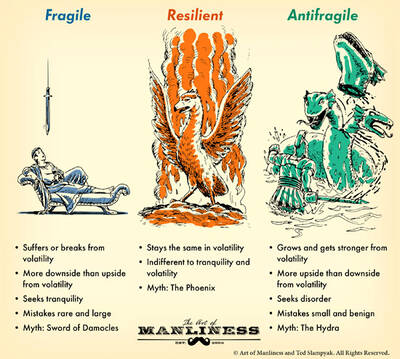
Coincidence or not, today new UN 'champions of the earth' were awarded, among which a leader of a sustainable island for governance realisation and a young Dutch entrepreneur who wants to cleanup the oceans for his inspiration and action.
The younger awarded for his ambitions and actions. Although he was sometimes criticized for unrealistic plans, solving symptoms instead of the problems behind, in a technocratic way - he cannot be criticized for doing nothing. The older leader was praised because under his leadership governmental plans were put into action. Among western and non-western world leaders this is perceived a remarkable effort!
These awards reflect two issues discussed during the course: how to bridge between vision and action, and how to make sustainability happen? Although nobody knows what exactly sustainability is, most of us realise that there is no single definition, answer or solution. It is about complex systems and solutions, in which many trade offs are to be made and balances searched for. Think for example about which light bulb to opt for: the low cost, low material, easy reuse energy drinking old fashioned one, or the advanced, complex and may be dangerous low-energy light bulb?
Deliberate choice and design will not be sufficient to change the world. They may face may obstacles between intentions and realisations. Only when designed for presence, taking people and their peculiarities into account sustainability transitions may happen. Transitions that on the long term not just 'preserve' the world we're familiar with, but even make it a better world. A antifragile world that learns and improves by resistance.
These two people have taken action to contribute to that. The younger by giving nature back to nature. The older by making promises come true. They took decisive action and may elevate sustainability to new levels. Can we contribute to that as well with our collaborative research and action?
Don't WASTE it
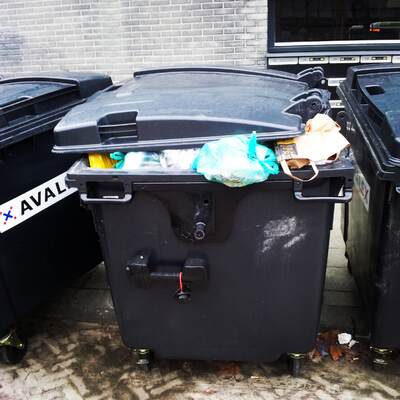
Listening to the lecture by Roel van Raak about waste management this week, I started to think about my own experiences of waste management. Growing up in a small town in northern Sweden, I was taught to sort my waste. In our house we hade a compost and our plastic, paper, cardboard, metal and glass waste were put in different containers at the local recycle plant every weekend. The most fun thing, as a kid, was throwing the glass bottles into the round containers and listening to the loud CRASH!
My parents sometimes brought me to the big recycle plant were electronics, chemicals, and heavier waste is sorted in an organized manner, free of charge. That plant also has a division for used clothing and furniture. The furniture is refurbished by a company helping unemployed and people unable to maintain a regular job, and eventually sold in the town center. Growing up, this was all part of my world and I didn’t reflect on it at all. Everyone recycles, right?
My view of recycling was challenged when I lived in the US, where it really takes more of an effort to recycle waste. In my city the garbage truck came every week, collecting regular garbage and a box where we were allowed to put mixed recyclables in a big mess, unsorted. The family I was living with didn’t have a system for sorting their waste, and I don’t blame them. The system was fuzzy and information was poor. In addition, the box where the recyclables were to be put was small and couldn’t hold the amount that a regular American family would produce in a week. I think this contributed to making them throw recyclables in the regular combustible garbage.
Moving to the Netherlands, I had another confirmation that I was lucky to grow up learning about recycling. The first day living in my house, I ran into the man responsible for maintenance. He showed me the garbage room, where everything is just thrown into one container. I asked why there was no recycling in the building and he said they used to have it, but “people didn’t respect it to the point where it was not working”. This really saddens me, since our recyclables now have to be carried around town to different areas for recycling. I miss the “waste cycle”-room in my old apartment complex where garbage could be sorted a few meters outside the door.
I think the key in succeeding to have a high percentage of recycling of waste in a city is simplicity. Property owners should make it so easy for people in their building to recycle that there is no question whether it should be done. Municipalities should give incentives to residents to recycle. There just shouldn’t be an alternative that’s more attractive than throwing that glass jar in a container and listening to the CRASH! as it becomes a part of a beautiful cycle.
The importance of preliminary community based research
“…sensitivity to local context and the local embeddedness of the project were key aspects determining the immediate successfulness of the project…” (Raven et al, 2008)
Taking into account the local context when trying to implement something new seems pretty obvious for an architect. However this is not always the case for other disciplines that affect our surroundings. New sustainable technologies have sometimes a negative effect on the environment and social systems even though it was planned with the best purposes. Therefore I think it is necessary to thoroughly investigate the context before implementing any new sustainable technique. A concept or vision based on proper research is a reasonable starting point for the actual implementation.
The vision can be built up from the perspective of the technology or from the perspective of the context. The first approach has a certain technology as a starting point. Its effects on the context will be investigated. Then it can be altered to fit the environment. You could say that this is a kind of made-to-measure approach.
The second one takes the context as the leading idea. The context has to be analysed at first. This analysis will make clear what the environment really needs. Sustainable technologies will then be looked for to fulfil these needs. Whether the technologies are suitable has to be determined by how it affects the natural environment and communities. This approach could be seen more as the haute-couture approach.
So, embeddedness in and sensitivity for the local context can be reached in two different ways. I think that the haute-couture approach will deliver the best results, because it is much more focused at the level of the community and environment. On the contrary, I think it is much more time consuming than the other method because of the extensive research that has to be done.
The made-to measure method is, I think, quicker, because you already know with which technology you want to begin. There are simply less options than when all options are still available. A negative side could be the backfire of unforeseen problems caused by the lack of preliminary research.
I think that it is most useful for the island of Texel to do extensive research before implementing new technologies. It is very important to know what the context is, because the island has such a small and strong community. The effects of changes are therefore much easier to be felt with a higher risk of disruption. Besides that, change is not really ad-hoc needed on the Island. So, people might take their time to analyse and test various alternatives to be sure that it fits the island in the long term.
Borris Boschman
R. Raven, E. Heiskanen, R. Lovio, M. Hodson, B. Brohmann, 2007, The Contribution of Local Experiments and Negotiation Processes to Field-Level Learning in Emerging (Niche) Technologies, Meta-Analysis of 27 New Energy Projects in Europe
The transition towards a biobased economy

The building sector is one of the largest consumers of energy and natural resources. In order to reduce this amount, it is necessary that production processes become more efficient and less labor intensive. The biobased economy aims make the transition from raw materials towards an economy, which uses biomass as a resource. By reusing materials in continuous, closed loops, we could significantly reduce the environmental burden of consumer wastes.
The building sector is one of the largest consumers of energy and natural resources. In order to reduce this amount, it is necessary that production processes become more efficient and less labor intensive. The biobased economy aims make the transition from raw materials towards an economy, which uses biomass as a resource. By reusing materials in continuous, closed loops, we could significantly reduce the environmental burden of consumer wastes.
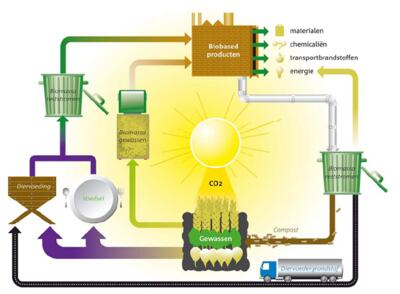
Rapidly increasing urbanization leads to a growing need for buildings in cities. Climate change increases the frequency of natural desasters with the consequence of destruction of millions of homes leading to a growing need for emergency shelter. But building construction already accounts for up to 38% of all CO2 emissions. This makes the building sector one of the largest consumers of energy. Buildings are one of the heaviest consumers of natural resources and account for a significant portion of the greenhouse gas emissions that affect climate change. Buildings use 40% of raw materials globally (3 billion tons annually). (Unknown 2014)
In order to reduce this amount, it is necessary that production processes become more efficient and less labor intensive. Many used materials such as steel and concrete have a slow production process. And during construction a lot of the materials go to waste. Therefore we need to find a way to use less raw materials. The biobased economy aims make the transition from raw materials towards an economy, which uses biomass as a resource. In a biobased economy biomass is used for non-food applications such as chemicals, materials, fuel, electricity and warmth. Biomass can function as a replacement for traditional materials and fuels used for these applications in which carbon is indispensable. (Unknown 2014)
To reduce environmental impact of the building industry it is of importance to make material selection based on the function of the design with the least impact on the environment which maximize the possibility of reuse and recycling after demolition.(Bijleveld, Bergsma et al. 2014) Taking this into account bio based materials could substitute a large amount of materials used today. It has become possible to substitute any building material with a biobased alternative or it can be developed upon request. (Runneboom 2013) The embedded energy of a biobased material is not necessarily less but the carbon footprint is better. (Spanjer and Wijk 2014) By reusing materials in continuous, closed loops, we could significantly reduce the environmental burden of consumer wastes.(Geiser 2001)
Bijleveld, M., et al. (2014). Meten is weten in de Nederlandse bouw. Mileu-impacts van Nederlandse bouw- en sloopactiviteiten in 2010. Delf, CE Delft.
Geiser, K. (2001). Materials Matter: towards a sustainable materials policy. U.S.A., Massachussets Institute of Technology Press.
Runneboom, T. (2013). The Green Village, TU Delft.
Spanjer, W. and P. A. v. Wijk (2014). Sustainable buildings Transformational Innovations. Delft, The Green Village, TU Delft.
Unknown (2014). Retrieved 20 November 2014, from http://www.biobasedeconomy.nl/wat-is-biobased-economy/over-bbe/.
Unknown (2014). "Green Building Facts." Retrieved 26 October 2014.
Grow your own food
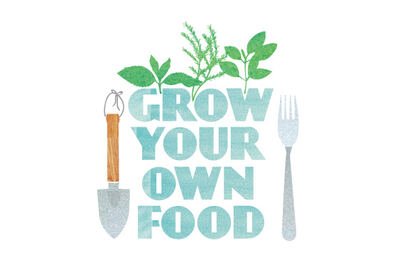
A big part of the food that we eat every day has travelled hundreds or thousands of kilometers, before getting in the supermarket from which we bought it. This can be defined quite unsustainable, if we consider the possibilities of growing food locally.
For example, the transport of food in U.S. accounts for 25% of the total energy use related to the food industry.[1]
Even though transport has an important impact on the total energy used, the whole supply chain has to be considered. It consists of a flow starting from the suppliers, shipped to the manufacturers and afterwards to the distributors, passing through the retailers and in the end arriving at the consumers. Energy for the production, the transport, refrigeration, manufacturing, packaging account for 25-30% of the whole greenhouse gases emissions every year.[2] If we consider also the fuel consumption of the people moving by car for the private food transport, the numbers are even worse. [3]
All this underlines that a more sustainable way of producing and supplying food should be found. Even for a small island like Texel, the supply chain can account for a big amount of energy consumption and co2 emissions.
A solution for the Texelaars and for anybody would be growing our own food. By creating a food garden at your backyard or on your balcony, or creating a local community food production would be a great reduction of the impact on the environment. You, as a consumer, have the opportunity of being of less impact on the environment.
Apart from the energy consumption and co2 emissions, this action has more sustainability-driven reasons to be applied: By planting your own garden, especially an organic one, you would help reducing the demands put on the lands by the commercial agricultural systems. It would reduce the amount of water used for plant irrigation. It would decrease the air and water pollution created by pesticides and fertilizers extensively used by the food suppliers.
Of course, the home-grown food would also have of other good points, such as:
- Improving the family’s health: eating more fresh vegetables and fruits is one of the main points of a healthy diet.
- Saving money: If we consider the costs for growing food at home, compared to the cost of everyday grocery, a big potential for energy saving can be found.
- It is a healthy practice that eventually could become a hobby.
- It would result in a better-tasting and safe food, because the vegetables will be always fresh, pesticide-free and without the risks of contaminations.
- Reducing food waste: It is estimated that in The Netherlands we waste one third of good food. It is mostly due to aesthetic quality, strict expiring dates and over-sized grocery.[4] By growing your own food, we would be more careful of our food, and we would not waste it.
Small initial efforts are required to get the knowledge and the experience of how to grow a food garden, but eventually it would only require 1 hour per day and become a nice and sustainable hobby.
Bibliography
1. Wayne Wakeland , Susan Cholette , and Kumar Venkat, Food transportation issues and reducing carbon footprint, Chapter 9
2. Grow your own food, http://onkaparingacity.com/onka/living_here/our_environment/sustainable_onkaparinga/garden/grow_your_own_food.jsp
3. André Viljoen, Johannes S. C. Wiskerke, Sustainable Food Planning: Evolving Theory and Practice, Wageningen Academic Pub, 2012
4. Food waste?, from http://damnfoodwaste
The unsustainability of the world’s financial system
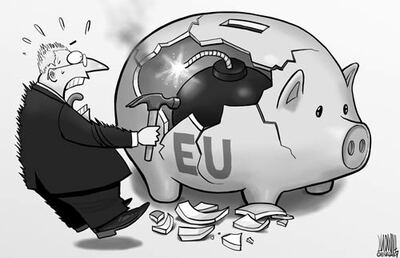
Nov. 2014
Hardly anyone saw the economic crisis of 2008 coming. Six years further down the road we are still feeling the pain of this crisis and it is likely that this tumor will be difficult to eradicate.
The crisis in 2008 happened because we have constructed a financial system that got out of control, where all parties seem to owe tremendous amounts of money to others in the system. In 2008 parties lost trust and the system instantly collapsed. If more money is ‘created’ than there actually is, you get problems. For example, you can increase the money supply by using the same money and lending it out several times. If you deposit 1000 euro at a bank and that bank lends this money to a third party, both that third party and you can claim the money. In other words, the system that we are currently using is fraudulent. Banks have figured out they only need to keep a small percentage of their deposits indoors, but the problems arise in times of economic crises. In economic downturns, bankruns can initiate where people claim back their deposit. If banks have spread their deposits in short and long term loans, they cannot withdraw money out of the long term loans for the short term customer demands. This can induce a loss of trust in money.
We are actually on the verge of losing faith in money. Not only are banks using the same money multiple times, loads of central banks are also conducting quantitative easing. This is a process whereby more money is printed in order to stimulate the economy. The federal reserve is already wielding this method for several years and the ECB is about to deploy it. In my eyes the perfect recipe for an economic disaster whereby entire populations can loose faith in money. Basically you loose faith in money by printing too much of it and someone all of a sudden realizes that this money is worthless. The way you know money is worthless, is because either you get a currency collapse or rising interest rates. What usually follows is a snowball effect.
At the moment they have lowered interest rates to unsustainable historic low rates where governments are buying the bond markets to maintain interest rates low so they can pretend that everything is perfectly fine. This creates a discrepancy though, between the real value of money and the value it represents, as the risk free rate, the basis of the capitalist system, does not reflect the actual risk of the system. In other words, the real inflation is way higher than the sketched inflation. Just look at the historic price rise of the stock exchanges, such as the Dow Jones, which has trippled in value after its low in 2009. These stocks have inflated mainly because of quantitative easing and hence represent a different inflation number than the numbers governments present us.
Is there a way out of this? Yes there is. Will it hurt? Probably. Fact is, the public debts will either have to be written off in agreement between national states, or another system will have to emerge that is superior. A combination is also fine. We could link the money supply to gold, like we have done in the past. If we want to increase the money supply, we would then have to increase the gold supply. The problem is that nowadays ‘paper gold’ has become the standard, such as derivatives or ETF’s, which in fact not really represent the true amount of physical gold. We actually got caught up in the same kind of game there. Fortunately there is hope and this hope is represented by a system with an unknown inventor. In order to adopt this system, we have to leave behind the old, diseased system.
I am talking about decentralized cryptocurrencies, such as Bitcoin, which operate on the blockchain system. This a public ledger, whereby irreversible transactions from peer to peer are published. The decentralized cryptocurrency Bitcoin boasts a few big advantages in comparison to the old system. There is a finite amount of them and just like gold, you have to ‘mine’ them, albeit not physically, but with computer power. Therefore it actually costs energy to release Bitcoin to the network. This instantly gives Bitcoin a value. As difficulty to mine Bitcoin increases when the supply of unmined Bitcoin decreases, more energy is needed and theoretically this would result in a higher exchange rate. Because of the limited supply, no more Bitcoins than the finite amount of 21 million can ever be created. This is a built-in protection against quantitative easing. Won't there be too little of them after some time? Most probably not, since Bitcoins are divisible up to 8 decimals. Moreover, Bitcoin transactions flow from peer to peer, without any intervention of banks or governments. This way, sums of money can instantly be sent from anyone to anyone all over the world, within a matter of minutes. Transaction fees are just a few cents, even on big sums of money, instead of a fixed percentage on top of the sum. Governments, nor banks, can freeze your account and confiscate your Bitcoin, because you are your own bank and you are responsible for your own security. And last but not least, a Bitcoin transaction can entail information, such as a contractual agreement. This makes the blockchain very appealing for all kinds of contracts, public information and other things, which can be attached to a Bitcoin transaction.
My guess is that during the coming years most of us will come to the abovementioned realizations and we will see the emergence of cryptocurrencies such as Bitcoin, Ripple and cryptos on top of the Bitcoin network such as Gems. This is a slow process, because leaving the status quo supported by governments and banks won’t be settled without arguments. If we succeed however, we can look forward to a way more sustainable economic system that enables innovation and fair trade.
-------------------
Risk free rate: The theoretical rate of return of an investment with zero risk. In practice, however, the risk-free rate does not exist because even the safest investments carry a very small amount of risk. Thus, the interest rate on a three-month U.S. Treasury bill is often used as the risk-free rate (Investopedia)
p.s. As in investment tip, I could also recommend Bitcoin. One Bitcoin is currently slighlty undervalued at around 300 euro, but it has the potential to reach values ranging from 100.000 to 1000.000 euro or even more, if massive blockchain adoption occurs. When buying Bitcoin, you are actually betting AGAINST the current, diseased, financial system and you are betting IN FAVOR OF a better system and a fairer distribution of money. Keep this in mind.
Why should we be sustainable?
Keywords: sustainability, environment, society, economy

It's no secret that people live longer and that is one of the main reasons why sustainable development is so important. According to the United Nations projects there will be more that 10 billion people living on Earth by the year 2100. The rise of the population means that there will be more demand of supplies and energy. If the energy continues to be developed by finite fossil fuels, instead of sustainable resources, the environmental damage will drive us to a dead-end. [1]
Sustainability has never been more important. People are being more and more informed about the need to be sustainable, but they don’t really know all the reasons. Let’s dive more into it.
The environmental changes were the initial concerns that woke up the population to consider that something was going wrong. The climate change, the ozone deterioration, the acid rain and the dead zones in the ocean were only few of the indications. Currently some improvements have started to improve the environmental condition, even though the air, land and water pollution is still a major problem. Most countries don’t have any special treatment for the waste and so they end up to landfills or the oceans. Even incineration that is considered to be sustainable, as it produces energy, causes air pollution due to the gasses. [2]
From an energy point of view, people have already used a huge amount of non-renewable resources. As the years pass by and people live longer, more of these resources are needed, which will finally be depleted. There are many kinds of renewable resources, such as using biomass, fuel cells, hydro, solar, wind, tidal waves and thermal forms of harnessing the earth’s natural elements. [1]
Economically, most companies are convinced that it takes a lot of extra money to become sustainable, which the customers will never pay. However, being sustainable will eventually help the business. The companies will become more efficient, improve their brand value and reputation, provide a platform for innovation, help attract and retain staff, achieve better growth, cut costs and strengthen stakeholder relations. [3]
Society has mainly the same concerns with the businesses. The costs, the additional infrastructures and the effort to convince people to change behavior are some of the main reasons to avoid and postpone any programs of sustainability and progress.
Over enough time, sustainable development will no longer be an option! It will be the only available way for cities and regional development. It's only a matter of time. The question is whether humans are going to make the transition toward sustainability on their own terms or if they will be forced to make a rapid transition when all of the other options finally run out. [1]
As a conclusion, there is no argument against sustainability. Sustainable development is cleaner, has the potential to be more efficient, has long-term potential and is the only way forward for a growing world economy.
1. ‘Why is sustainable development important?:
http://greenliving.lovetoknow.com/Why_Is_Sustainable_Development_Important
2. ‘Seven biggest environmental threats’:
http://greenliving.lovetoknow.com/Seven_Biggest_Environmental_Threats
3. ‘Why should my business become more sustainable? :
http://sustainable.org.nz/what-we-do/sustainable-tools-resources/pathway-to-sustainability/guide-to-sustainability/
LEARNING FROM TERMITES HOW TO CREATE SUSTAINABLE BUILDINGS
BIOMIMICRY: A SUSTAINABLE TOOL
KEY WORDS: Biomimicry, Sustainability, Nature
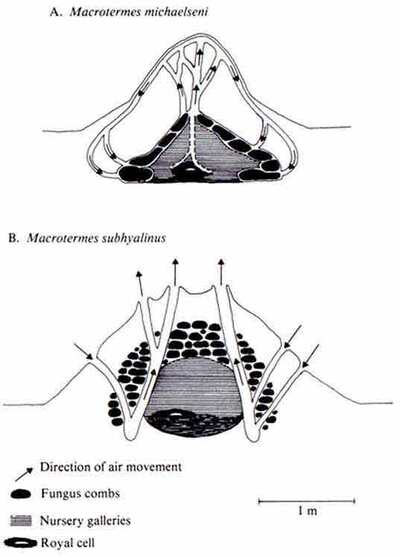
According the biologist Janine M. Benyus, biomimicry can be defined as imitating or taking inspiration from nature’s forms and processes to solve problems for humans. Indeed, she claims that it is necessary to imitate nature to ensure a more sustainable future. Regarding all these factors it is possible to say that biomimicry introduces an era based not on what people can extract from the natural world, but on what people can learn from it. Therefore, biomimicry is an innovation method that seeks sustainable solutions by emulating nature’s time-tested patterns and strategies. (Benyus, 2002) (BiomimicryGroup, 2014)
In fact, nature has been tested strategies for 3.8 billion years and biomimicry helps study the successful strategies of the survivors and allow humans to apply them within innovative sustainable designs. For instance, engineers from firm Arup, led by Mick Pearce, sought inspiration for the ventilation design from termite mounds in order to design the Eastgate Complex in Zimbabwe; thus, generating passive cooling buildings.
People generally think of termites as destroying buildings, not helping design or improve them. But the Eastgate Building, an office complex in Harare, Zimbabwe, has an air conditioning system based on the self-cooling mounds of Macrotermes michaelseni, termites that maintain the temperature inside their nest to within one degree, day and night (while the temperatures outside swing from 42 °C to 3 °C).
Actually, the operation of buildings represents 40% of all the energy used by humanity, so learning how to design them to be more sustainable is vitally important. Designed by architect Mick Pearce, Eastgate uses 90% percent less energy for ventilation than conventional buildings its size, and has already saved the building owners over $3.5 million dollars in air conditioning costs.
Strategy: Biologizing the problem
Problem definition:
Creating a passive cooling system for a 324 000 square-foot commercial, office and shopping complex located in Zimbabwe, based on natural principles.
Reframe the problem: ‘biologizing’ the problem:
Biological analogy: Termite mounds
Biological solution search:
Termites build their mounds using zero-waste construction methods, employing solar-powered air conditioning and developing a sustainable agriculture system. Actually, the forms of the mounds change according to the location; however, regarding scale of those mounds they can be compared with skyscrapers for human beings. Furthermore, the forms of termite mounds represent elaborate systems for thermal control in order to generate optimum thermal conditions for egg-laying fungus farming.(Pawlyn, 2011) (Turner & Soar, 2008)
Define the biological solution:
The mound created by compass termites (Amitermes meridionalis) in Western Australia.
Principle extraction:
The mound created by compass termites has the shape of a flattened almond with a long north-south axis that catches the light during the day and release heat during the night. Besides, many ventilation tubes are located within the walls. What is more, termites are able to open and close a series of heating and cooling vents throughout the walls of mound during the day. Hence, when interior temperature rises too high, vents can be opened; thus, rising warm air by stack effect. (Pawlyn, 2011) (Doan, 2012)
Principle application:
The solution was a passive-cooling structure with specially designed hooded windows, variable thickness walls and light coloured paints to reduce heat absorption. The construction is based on a heavy masonry construction, which uses an external shading system that helps to minimize the solar heat gain. Furthermore the cool air is circulated into large floor voids that have a labyrinth of precast concrete elements that maximize heat transfer by having a large surface area. What is more, 48 masonry chimneys are used in order to provide adequate ventilation that keeps the interior temperature between 21ºC and 25ºC, while the outside temperature range between 5ºC and 33ºC. (Pawlyn, 2011) (Turner & Soar, 2008)
Bibliography
BiomimicryGroup. (2014). Biomimicry. Retrieved November 21, 2014, from Biomimicry 3.8: http://biomimicry.net/about/biomimicry/
Doan, A. (2012, November 29). BIOMIMETIC ARCHITECTURE: Green Building in Zimbabwe Modeled After Termite Mounds| Inhabitat - Sustainable Design Innovation, Eco Architecture, Green Building . Retrieved November 21, 2014, from Inhabitat: design will save the world: http://inhabitat.com/building-modelled-on-termites-eastgate-centre-in-zimbabwe/
Pawlyn, M. (2011). Biomimicry in Architecture. London: RIBA Publishing.
Benyus, J. M. (2002). Biomimicry: Innovation Inspired by Nature. New York: HarperCollins Publishers.
Turner, J. S., & Soar, R. (2008). Beyond biomimicry: What termites can tell us about realizing the living building. First International Conference on Industrialized, Intelligent Construction (I3CON), Loughborough University , 1-18.
Thinking about sustainability
Looking around in the Netherlands it is easy to become really pessimistic, we don't separate our waste properly, buildings are consuming way too much energy, we shower too long, eat too much meat and on top of it all we pay way too little for those actions.
Looking around in the Netherlands it is easy to become really pessimistic, we don't separate our waste properly, buildings are consuming way too much energy, we shower too long, eat too much meat and on top of it all we pay way too little for those actions.
As someone who has a habit of always looking at thinks from multiple perspectives, regularly pissing off friends who try to complain, sustainability can keep me really occupied. Though everyone agrees on the nescessity of a more sustainable exploitation of our planet most solutions are easily contradicted. Either because of the costs or due to another argument proving how a part of this new solution is worse than the old one. In the mean time, hardly anything seems to happen.
Luckily, that's where I think the positive part is: take care of the pence, the pounds will take care of themselves ("alle beetjes helpen") is my motto here. Off course we won't be able to solve all our problems within a day! But sustainability is gaining more and more attention, every big company has to mention it on their website, (preferably in combination with a sign showing a green check mark), it is incorporated in almost every course at our university and on a household level: 2,5 million Dutch inhabitants recently recieved a check from the Postcode Lotery stimulating them to buy sustainable groceries.
Though there is a large pathway to be taken, the first steps are clearly visible in our society. And though we will always be forced to look at our behaviour critically, we recently learned how energy saving light bulbs might have been a step back, I think we all find some satisfaction in helping our planet leading us to the right decisions. Therefore I try to look at it from a positive side: we can all be proud to participate in this transition, even if it's only by being a little bit better every day!
Sustainability all over Europe
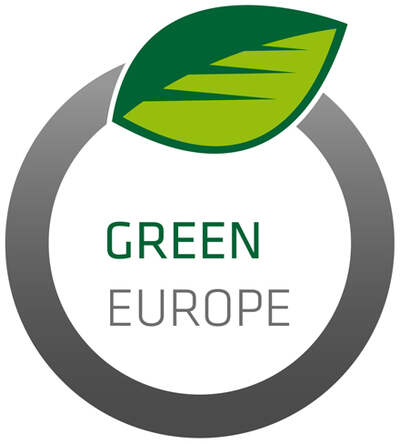
Not only in the Netherlands, but throughout all the countries in Europe plays sustainability an increasingly important role. Not only is this reflected in the European regulations, this is also shown by the interest of European student. Last week a large number of students from various technical universities throughout Europe come together for the ATHENS program in Budapest to learn more about sustainability.
A total of 90 students participated in three different courses in Budapest. I was one of these students that participated in this ATHENS program. Last week I followed a one week course at the Budapest University of Technology and Economics about sustainable reconstruction of historic buildings. The existing building stock is one of the biggest problems in the field of energy loss throughout Europe. In groups of 6 students we had to design a sustainable reconstruction plan for one of the many old historic building in Budapest. In this building one of the most famous Hungarian glass artist, Miksa Roth, used to have his workshop place. Within the group , each student had its own background and idea of sustainability. After several lectures, site visits and many discussions we came together to a plan for this building on how to insulate, how to cool and heat the building and how to construct this. With the new function of an impact hub, a working space for young entrepreneurs and a fablab, we brought a total new concept to Hungarian. After evaluation our group was elected by the students groups as the best plan for this building.
By participating in this course, through the lectures and the many discussions I discovered that the Netherlands is not so bad in the area of sustainability. Especially Northern countries, like the Netherlands and Germany are seen as examples in the field of sustainability. But even I, the only Dutch girl, in this course have learned new things in the field of sustainability during this short week. It was really interesting to get to know so many students with different backgrounds who are all interested in sustainability. I really hope all these young people will bring Europe a more sustainable future together.
The fairytale of drinking water (column 2)
The history of clean drinking water
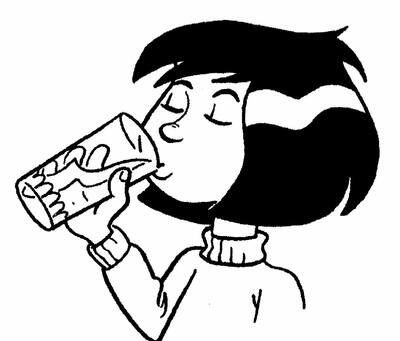
… Once upon a time, in ancient times, people established their permanent settlements around water sources like rivers or lakes, in order to have access in water for their needs. I n this time, the purification of the water was determined by the taste and the visual observation.
The visual cloudiness /turbidity was the driving force to start the water treatment method in early 4000BC. Ancient Greeks and Romans writings referred to some water treatment methods such as filtering through charcoal, exposing to sunlight, boiling, staining and dipping seven times into a piece of hot copper and then cool it in an earthen vessel.
During 17th-18th century, thousand of experiments for water purification including percolation, distillation and coagulation were introduced and spreaded worldwide. The first idea of water desalination was in 1671, when Sir Bacon starting purifying seawater by passing it downward through 20 vessels, and he assumed that if he dug a hole close to a seashore, he would get pure water after the seawater had passed through the sand. In 1908, chlorine was used for the first time as a primary disinfectant drinking water in Jersey City after of 130 year of its first discovery in Sweden.
During the 19th century, the water quality had a significant impact in health and a lot of diseases like cholera were decreasing after the installation of treatment systems.
Nowadays, especially in most developed countries the drinking water meets the regulated standards and filtration and chlorination remain effective treatment techniques for protecting water but are continually being refined based on our better understanding.
… and they all lived happily ever after
P.S. However, because real life is not a fairytale, I would like to mention that over than one billion of people worldwide lack of access of clean, safe drinking water and the other three billions of people take the water for granted (?)…
E.G.
Good working windmills demolished due to governmental subsidy policy
Column week 2
When I saw the news this week I was again very disappointed in our governmental policy regarding sustainability. At first I could not believe this, but it happens to be that because of a certain subsidy it is now financially attractive to replace a good working windmill by a newer one. These “old” windmills are technically in perfect state and could easily work for at least 15 more years, but because of their age - mostly about 10 years - they are no longer eligible for green electricity subsidy. Since it is more beneficial to have a windmill running that is subsidized, it is now cheaper to replace the old mills with newer ones that do get this subsidy. This means that a lot of public money will be wasted because there is no net improvement of sustainable energy gain and additional pollution is caused by the replacement operation. According to the Volkskrant we are now talking about at least 172 big windmills, which will generate a subsidy of 350 million euros[1]. I’m really asking myself how this policy ever got through, seeing what its consequences are now..
So let’s shortly explain what’s going on here. As we all know the government is putting a lot of effort in achieving the EU20-20-20[2] energy goals, which inter alia state that 20% of the energy production should be from renewable sources. The Netherland already lowered this figure to 14% renewable energy production in 2020[3] and even this is unachievable[4] if the current efforts are extrapolated according to the CBS (Statistics Netherlands). To illustrate this: in 2012 the renewable energy production was only 4,4%[5]. The problem here is that the government has only a few means to actually change the way energy is produced. Most policy is built around subsidies because they have the fastest results, but as one can see, this does not always lead to sustainable solutions.
The topic of this week was: “from vision to practice”, and I think this news item is a perfect example that shows what can go wrong during this process and the huge challenge the government is facing by making European agreements. Although the government is trying their best to make changes, the energy market itself should also come up with initiatives and not only take action if there’s a financial benefit. This might require a different policy and thus the government should reconsider what role they have to play in the process and come up with an effective policy regarding renewable energy production that is less subsidy based.
Thankfully the Ministry of Economic Affairs announced that this subsidy program will be changed in 2015 so that it will no longer be financially attractive to replace and older windmill with a newer (identical) one. But in my opinion this is already too late; every operator that currently has these old windmills would be crazy to not make use of the subsidy, so I think the government can expect a lot of extra applications before the end of the year…
- Jesper
[1] http://www.volkskrant.nl/binnenland/nog-goede-windmolens-worden-vervangen-vanwege-subsidiestop~a3791781/
[2] http://ec.europa.eu/clima/policies/package/index_en.htm
[3] http://www.rijksoverheid.nl/onderwerpen/duurzame-energie/meer-duurzame-energie-in-de-toekomst
[4] http://www.telegraaf.nl/binnenland/23158817/___Duurzame_energie_onhaalbaar___.html
[5] http://www.cbs.nl/nl-NL/menu/themas/industrie-energie/publicaties/artikelen/archief/2013/2013-3827-wm.htm
Luxury and sustainability
Luxury and sustainability... Two words that are seemingly opposite. It is a fact that when we use luxurious transport options like an airplane, it is less sustainable as against a train. But luxury also implies to brands and good they offer for also our day to day usage. It is a fact that more there is an increase in the number of people wanting prada bags, super cars, luxury bathrooms and the likes. In this column, I want to share my views and findings on how well luxury brands are embracing sustainability and its effect in the consumer market.
Re-designing consumerism by using behavioral economics may offer an enjoyable path - and may work. Reducing, reusing, recycling and disposing responsibly have been the mantra for saving the planet for decades. However, another workable option could be increasing spending on our aspirations by channeling our purchasing power to where we might do the least harm - by buying sustainable luxury goods.
Here is a pop quiz question: Which iPhone hurts the environment most when produced? An iPhone 6 (requiring 95 kg CO2) or an iPhone 6 Plus (requiring 110 kg CO2), which is 15 percent more CO2 than the former?
The correct answer is the iPhone 6 Plus with 110 kg CO2. What is important is how much environmental hurt one can cause per dollar (EcoValue) and the iPhone 6 Plus sucks up twenty percent more capital per unit CO2. When the iPhone 6 Plus sucks up three hundred dollars more of your purchasing power, it prevents you from doing environmental harm with your cash somewhere else. Just imagine how much a $50,000 Chanel evening gown, a $1,500,000 Ferrari or 100,000,000 Monet painting reduces your ability to hurt the Mother Earth. (S. Petersen, 2014)
If we see luxury in the light of durability or the shelf life of goods, the energy in production and recycling is far less than the ones with a shorter shelf life. Luxury items are typically ones with a high quality which implies a pride in buying less. In that sense, it is far less a burden in buying a good quality product. However, when the term sustainability to the product itself is applied, it is not sufficient to label them as sustainable to drive the market towards buying these goods because customers will not give up quality or style or fashion appeal, or a competitive price for a sustainable product. (M.A Gardetti and M. E. Girón, may 2014)
Gardetti and Girón in their research define the need for traceability, also their approach to define if a product delivered to the consumer in light of sustainability. Where do things come from? What is the story behind the products we consume or the services we use? What footprints have these products left on the environment and on the people who create, manufacture, sell or consume them? The journey to the past to understand where a product comes from, its components, raw materials and their extraction, is what is known as traceability.
According to the research by Added Value Group, a brand developing and marketing service, This new spirit of luxury is starting to creep in across categories and geographies:
Yves Saint Laurent's New Vintage III range: a contemporary, fashionable form of up-cycling that re-exploits unused fabrics from past seasons, employing them to reinvent the emblematic silhouettes of the designer. Hence, the range reinterprets the brand while maintaining its authenticity.
Hermès creation of Shang Xia, a new Chinese luxury brand of graceful, contemporary handcrafted decorative objects. By supporting local artisans in China, Hermès offers a modern and localized adaptation of authentic savoir-faire.
BMW's Efficient Dynamics technology was created to deliver reduced emissions and fuel consumption with no sacrifices made to driving pleasure.
So, all in all, to make a sustainable luxury product, the companies involved should take the following into account:
Redefine the product life-cycle
Give importance to supply chain
Consider upcycling old products ( and in turn generate employment ? )
Re-invent luxury experience by new materials/ better sustainable performance of products by not compensating the quality.
Last but not the least, although the luxury goods are meant for the rich and the affluent, the sustainable luxury should aim to slowly trickle down to the less affluent masses.
References:
www.wpp.com/wpp/marketing/consumerinsights/sustainability-and-luxury/ (analysis by added value group
‘How Sustainable Luxury Can Save The Planet‘; S. Petersen, Dr. Gjoko Muratovski; 2014 (www.huffingtonpost.com/soren-petersen/how-sustainable-luxury-ca_b_6118512.html)
Sustainable Luxury and Social Entrepreneurship Stories from the Pioneers; M.A. Gardetti, M.E. Girón, May 2014
How old is sustainability?

Trying to find a topic for a column of this week, I came up with the idea, that I actually do not know anything about the history of sustainability. Where does this term come from? When was it used for the first time? Or maybe the world without sustainability hasn’t ever existed? I always assumed that sustainability and everything that goes along with this word is a discovery of the past decades, not even centuries. Therefore I questioned myself, why am I so confident about it and if it is really the way I think it is. So, my column for this week would be about the origin of sustainability and its history.
Trying to find a topic for a column of this week, I came up with the idea, that I actually do not know anything about the history of sustainability. Where does this term come from? When was it used for the first time? Or maybe the world without sustainability hasn’t ever existed? I always assumed that sustainability and everything that goes along with this word is a discovery of the past decades, not even centuries. Therefore I questioned myself, why am I so confident about it and if it is really the way I think it is. So, my column for this week would be about the origin of sustainability and its history.
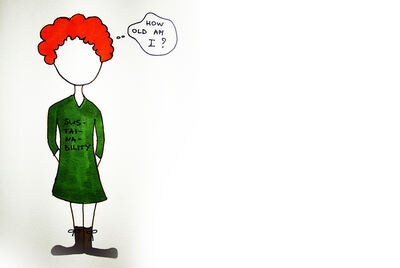
Actually, we can trace the presence of sustainability till the earliest civilizations. According to archeologists the sustainability of past civilization resulted in the ability to resolve arise problems and overcome decline and being able to maintain their needs at the same time. In other words, sustainable decisions were a way to prosperous and long existence for our ancestors (1).
The industrial revolution forced the modern society to rely more and more on fossil fuels, because more powerful machines were needed to satisfy the growing demands of the population. This is when the first responses to an increased level of air pollution occurred and initiated the so called ‘environmental movement’. In the middle of the 20th century this movement brought to the light the concerns about the undefined environmental costs of some innovative materials, such as plastics, nuclear energy, pesticides, etc. Since then more and more environmental problems were being looked at. In the report “Our common Future” from 1987 Brundtland Commission used the term sustainable development. This is the most quoted definition of sustainable development: "development that meets the needs of the present without compromising the ability of future generations to meet their own needs.”(2) In the beginning of the 21st century the awareness of the harmful effect of our society has reached global scale. Topics about renewable energy sources, greenhouse effect, urban island effect and many more are not new to us anymore.
Regarding the question about the “age” of sustainability, I would probably state, that sustainability is not new, because being unsustainable leads only to decline. Maybe our approach of today towards sustainability is more scientific and technology based and previous civilizations were sustainable more on the intuitive level. Therefore, it doesn’t matter how it was called or to what extend sustainability existed in human-beings daily lives, because being sustainable is the only way towards the future.
-
The Origins of sustainability (http://www.webpages.uidaho.edu/sustainability/chapters/ch01/ch01-p01.asp), retrieved on 20-11-2014
-
United Nations, ‘Report of the World Commission on Environment and Development.’ General Assembly Resolution 42/187, 11 December 1987.
Smart Highways
The Dutch artist Daan Roosegaarde has recently gained a lot of media attention with his smart highway concept. In this concept he envisions the roads of the future. According to Roosegaarde, future roads should be interactive by using light, energy and road signs.
The first experimental trajectories have already been realised in cooperation with Heijmans N.V. Near Nuenen a bicycle lane has been painted with a special paint that resembles Van Gogh’s painting ‘Starry night’. The paint is charged in the daylight and glows during the night. This same paint was also used to paint the lines on the N329 near Oss. In this trajectory the glowing lines are used to improve safety and visibility during the night.
A part of the concept that has not yet been realised by Roosegaarde is the ‘wireless priority lane’. Electric vehicles should be able to recharge while driving in this lane. The technique to wirelessly recharge a car is already available for static use. Companies like Plugless sell devices for consumer use. Experiments with dynamic charging are being conducted at this moment. A company that has made a lot of progress in this field is KAIST OLEV, a spinoff firm from the KAIST University in Seoul. This company has been able to realise a trajectory on the KAIST campus on which busses fitted with a dynamic wireless charging system are used. The charging strips are placed in sections were the busses need to accelerate or climb a hill. Using these strips enables the manufacturer to reduce the size of the batteries to one third of the size that otherwise would have been necessary. This enables a weight reduction that makes the busses more cost and power efficient.
When my group was assigned with the mobility sub-system this idea immediately came to mind. The few trajectories of the busses in Texel are relatively short and they do not leave the island. The adaption of the roads would require only little work. If the Dutch government would be interested in using the KAIST busses, Texel could be an ideal testing location in the Netherlands.
Dutch life quality
According to the Dutch Central Statistical Office (CBS) the Dutch life standard is quite high. Dutch people give their own life quality an average of an eight, which is obviously quite high [1]. The overall health is good and mutual trust is high. There is, however, a problem.
To keep this high standard up, the Netherlands produces relative much greenhouse gasses per capita. Not only because it cost relative much to keep the quality high, but also because the Netherlands is an important transit country. Production of products, mostly in developing countries, usually has quite a large impact on the environment, biodiversity and commodity stocks. And these products are also imported (and exported) by the Netherlands, contributing to the impact of Dutch consumption and life standard to the global environment.
While this problem is known, the Dutch government still focuses on energy- and CO2 emission targets. This is a good focus, but a sustainable future is a lot more than investing in energy and CO2 emission. For example citizens' initiatives and public support for sustainable innovation is almost being neglected. These aspects, however, can really contribute to a more sustainable way of life and probably increase the life standard in the Netherlands. It almost sounds like a missed opportunity.
In my opinion the government should increase investment in local innovation, citizens' initiative and public support. This way the Dutch public might change their way of life, if only by a little, toward a more sustainable way of life. And with local initiatives and innovations, the local environment will probably improve also. A win-win situation. Finally an additional advantage might be to export this knowledge, increasing export revenues and our global reputation.
[1] http://www.cbs.nl/nl-NL/menu/themas/dossiers/duurzaamheid/publicaties/artikelen/archief/2014/2014-074-pb.htm
Dance for sustainability
This week we will be visiting Rotterdam. We won't be able to visit the Club WATT unfortunately, because it shut down. It was a club where the energy of people dancing was used to power the club itself. This is a great sustainable idea, and I remember that I calculated the impact in my first year of physics. This back-of-the-envelope calculation would go something like this:
Say, we have people all waying on avarage 70 kg, a reasonable expectation in a club. Dancing is a complicated movement, but say we all just jumped instead of dancing, which is somewhat like dancing. Let's say, we jump very enthousiastically and raise our centre of gravity 15 cm each time we jump/walk, this is maybe a bit much but we're in a club, so we'll go with it. In this club they say they 'convert kinetic energy as efficiently as possible', we can assume an efficiency of about 10%.
If you jump up and down you use energy, the energy to raise your centre of mass with the 20 cm's we discussed before. Our average person would then use about 105 J to do this, what would give 10 J to the floor. If we would jump once a second, what we won't be able to do for very long, we would generate 10 W per person. This is enough to power one tiny lightbulb.
The club had enough space for 1300 people on the floor. If, on a very busy night, a quarter of these people are dancing at a time (the other people are either getting a drink or too tired from dancing so much), their dancing would generate about 3 kW. We could power two smoke machines! [1] Okay, if we would dance twice as hard (we're saving the world from climate change - we should put our backs into it) we could power the DJ set as well!
I think this short and easy calculation shows the problem with sustainability. Even though the idea is great, you should really do a calculation before assuming ecofriendliness.
[1] http://www.rookmachineverhuur.nl/product/7/rookmachine-1500-watt-huren-verhuur.html
Destruction of windmills to promote sustainability
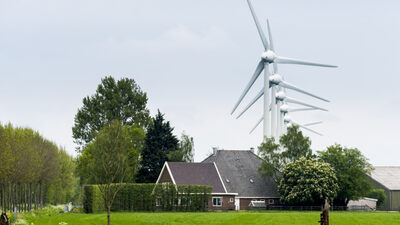
Last week I read in the news that relative new windmills are demolished to be replaced by new windmills in order to get subsidy of the government. Where the government tries to promote green energy by investing 350 million euros into subsidy, it is used by greedy investors just to earn money. How can this happen?
No one with a 100% working brain would demolishing their own windmills, certainly not when they are in good condition and producing green energy and make money. This can only happen when you will get rewarded by doing this. The subsidy of the government, which is money of the public, is misused with this construction. It is capital destruction to demolish these windmills that are only 10 years old, whereas it has a live time of minimal 15 years.
How can we reach a sustainable society when these steps are made? If government, that has the best intentions, but are rewarding the people that misuse the public money. And how is it possible that people that own windmill parks, where you would think that those people are the most sustainable people in The Netherlands, are so driven by money that they are tempted to misuse these subsidies?
What about the people that works hard on a sustainable society by trying to save energy in their house, paying attention to what they buy and trying to improve their footprint? They are not rewarded by the government. These people are the role models of the sustainable society. Sustainability starts with yourself and your role model is in this case not the people, who own big windmill parks while misusing public money for their own good, or government that is sleeping, but your neighbour that insulates its house and grows their own vegetables in their garden.
Cooperation or prevention of cheating?

This column is about a lecture of an evolutional ecologist. Toby Kiers found out that nature does not excel in cooperation, but excels in preventing stakeholders from cheating. What does this mean for our projects?
This column is about a lecture of an evolutional ecologist. Toby Kiers found out that nature does not excel in cooperation, but excels in preventing stakeholders from cheating. What does this mean for our projects?
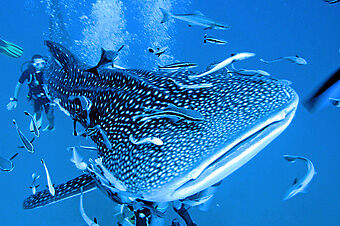
For sustainable designs to be implemented, the designs should be locally embedded, provide local benefits, establish continuity with existing physical, social an cognitive structures and apply to locally appropriate communication and participation procedures (Raven, 2008). In short, the project should meet the needs of all stakeholders for successful implementation. This makes business models important.
On 6 November an Evolution ecologist named Toby Kiers gave an interesting lecture on how nature cooperates, so attendees could incorporate this in their products as nature has beautiful ways to solve problems and has done so for centuries.
Instead of explaining how well nature cooperates, she explained how organisms in nature always look for ways to cheat. For example, fish who clean other fish take a bit of the fish if they have the chance. Nature is programmed to look for efficient ways and to cut corners when possible. Humans are not different from that. Toby Kiers gave a recognizable example of high school students who try to cheat, which made the whole audience laugh.
The reason why cooperation works in nature, is that nature prevents organisms to cheat by punishment. Nature even incorporates forms of slavery and makes organisms dependent on each other so they cannot cheat. Suffocation, enslavement, abortion, forced addiction and poisoning are strategies nature uses to force good cooperation.
She ended the lecture with the notion that when creating sustainable business models you first have to look where stakeholders have opportunities to cheat. Once you have identified these, you have to create punishment in case they do so, which will prevent the collaboration system to collapse. By creating punishment, you make sure each stakeholder sticks to the deal.
I think this is vital for circular product/service design where cooperation between stakeholders is essential for making the system work. For example, if waste of company A is transferred to company B as a valuable resource, company B relies on a constant stream of waste to guarantee continues production. Company A relies on that it can sell their waste to company B. In other words they have to be able to count on each other and not suddenly give their resources to another company because they can make more money there. Hence, there needs to be some kind of contract. But there may be more creative ways that use suffocation, enslavement, abortion, forced addiction and strategies in an innovative way.
For our projects now it means that we have to be aware that people do not always want to maintain good cooperation. Stakeholders are in it for self-interest reasons and not for the common good. Seen the amount of invented sustainable technologies, I think there is a relatively low implementation rate which can be caused by the fact that stakeholders are not always in it ‘to save the planet’. When communicating a project, benefits to all stakeholders must therefore be clear. And as I learned from Toby Kiers you have to integrate punishment in the system to maintain cooperation once stakeholders have joint the project.
You can review her lecture and other lectures on circular product/service design https://collegerama.tudelft.nl/Mediasite/Play/d23744e9ca4d4db5ba79fb8e7d38e2a51d.
Waste is an old-fashioned word
Within the next 7 weeks my columns will consist about two things; first I will identify the main challenge of that week. Then, I will write about a few Climate-KIC initiatives that are trying to deal with these problems. These initiatives can be either start-ups or Climate-KIC projects. As a Climate-KIC student, I am trying to promote my platform and hope to inspire my fellow students with initiatives from the Climate-KIC community. This week: Waste!
Within the next 7 weeks my columns will consist about two things; first I will identify the main challenge of that week. Then, I will write about a few Climate-KIC initiatives that are trying to deal with these problems. These initiatives can be either start-ups or Climate-KIC projects. As a Climate-KIC student, I am trying to promote my platform and hope to inspire my fellow students with initiatives from the Climate-KIC community. This week: Waste!
Hello. My column of this week will be written about waste. Although I couldn't attend this week due to a conflicting class on Climate Ethics, I did take a look at the powerpoints that were posted. Especially the one on waste I found very inspiring. Why? Well, for one it is the main topic of the subsystem my group has to deal with. But what is inspiring about waste, one might wonder.
Well, waste is in my opinion a bit of an old-fashioned concept. In fact, I prefer to look at waste as an unsorted collection of useful stuff that people don't consider useful anymore, therefore free to collect and to process in any way you like, if you want to make money on it! Some people who will agree with me on this statement is the Dutch Climate-KIC start-up 3R Waste Management who look to collect plastic waste and turn it into quality virgin plastic again!
Around 13% of the waste produced by Texel civilians are plastics. In 2012, there was around 3800 kg of "other waste" produced by the Texel civilians. So this accounts for about 500 kg plastic a year. What if this could be sold to this Dutch start-up I mentioned in the previous alinea?! In fact, there are more solutions like this. I believe that if you get the civilians of Texel to sort their waste very well, this might yield some interesting revenues.
So, turning waste into money hm? But how much money exactly? Say, I have a lot of used envelopes here, like, a lot! About 0.5 ton. So what's the value of that? The answer is unfortunately; not really a lot. Around €40 according to DeAfvalmarkt.nl. This innovative website is a platform where waste producers and waste processors can find eachother and trade their waste for money. Of course, it is not a lot of money. But hey, €40 is more than when you just dump it in the container around the corner, right?
So, if we can consider waste a resource, isn't Texel just lucky that they have this high amount of waste per person due to the tourists that visit the island? In the future this might just be turned into a profitable business!
Black Pete? Green Pete!
Black Pete? Green Pete!
It is only a couple days until it is the 5th of December, which is in the Netherlands traditionally called "pakjesavond". Sinterklaas arrived a few weeks ago in his steam ship together with his servants, also known as Black Petes. As you have probably noticed, there is an ongoing discussion about the skin colour of "Black" Pete. The documentary "Zwart als roet" (meaning: black as soot) by Sunny Bergman inspired me to write this column about Black Pete.
As a native Dutch citizen I grew up with this tradition. I was told that Black Pete became black because he was entering the house by the chimney and became black of the soot he was facing. Each year they came to visit our village by horse, about one week after they arrived in the Netherlands by a steam ship full of gifts. Sinterklaas checked if I have behaved last year using his 'great book' and if so, I received gifts from the always funny and kind Black Petes. However, opponents of Black Pete argue that Black Pete is a 'racially stereotype of the black human being' (Zwarte piet niet, 2014) and should therefore be omitted. They relate the Dutch history of slavery to the colour of Black Pete. I do not want to judge the groups who are in favour of or against Black Pete and say if they are right or wrong. The colour of its skin is based on a tradition, and whether this tradition is based on a morally right or wrong (historical) fact, I am convinced that traditions can be altered to maintain the idea of Sinterklaas without the disadvantage of feeling acts of racism.
The first image of Black Pete dates from 1850 (Stichting Geschiedenis Kinder- en Jeugdliteratuur, 2014) but I am wondering what he would look like if its character was created these days. In the light of this course I will sketch an image of a sustainable Pete.
At first, a steam ship is not especially an example of sustainable transport. I would suggest a sailing ship, although this could lead to increased travel time. Traveling by horse is not considered as unsustainable, but you could argue if roofs are the most effective infrastructure for distributing the gifts, at least it does not increase the congestion on the Dutch highways.
The second aspect that I would like to address is the number of gifts. From the documentary, one states: "Sinterklaas is one big capitalistic party to encourage the consumerism". Children receive many gifts during these weeks and almost all of these gifts are bought in a store. Because of the volume of the presents, they often do not play with all of their presents. To limit the consumerism, Sinterklaas could buy his presents at for example a second hand shop. And instead of a carrot in a shoe (I doubt that Amerigo can eat all the carrots and waste of food is of course not desirable), the kids could even give their 'old' toys to Sinterklaas, so he can give them to other kids.
Finally, the wooden stove is in most households replaced by a central heating system. Due to an absence of chimneys, the Petes have to come up with another way to enter the house. To prevent major heat losses, a small rooftop window should be perfect.
Since the sustainable Pete does not have to face to soot anymore, another skin colour would be appropriate. As this Pete is representing sustainability, I will introduce to you: "Green Pete"!
Bibliography
Stichting Geschiedenis Kinder- en Jeugdliteratuur. (2014, 12 2). Schenkmans Sint Nicolaas. Retrieved 12 2, 2014 from Het oude kinderboek: http://www.hetoudekinderboek.nl/archief/BomNikolaas/BomNikolaas.htm
Zwarte piet niet. (2014, 12 2). Zwarte piet niet. Retrieved 12 2, 2014 from Zwarte piet niet: http://www.zwartepietniet.nl/
After I wrote this column, I found out that there is already a Green Pete (see link: http://www.groenepietgame.nl/)
Sustainability hypes and trends
Sustainability hypes and trends
Sustainability is fashionable. Green and brown letters, leaves, globes, plants , checkmarks, quality stamps, you see those elements everywhere, in supermarkets, restaurants. Everyone tries to send the message to the consumer “we are sustainable/ ecological”, even Mc Donald’s is “green”.
Besides the fact that you could ask yourself if these companies with leaves and plants in their logos are really as ecological as they claim, we should think about the future of sustainability in commerce.
I am sure many companies do their best to be ecological and sustainable, but nowadays it mixes with companies who only look sustainable. People want to buy products that look like they are no harm to the environment but you can’t really tell anymore because all labels and packages are green and have leaves etc.
What concerns me the most is that this might be just an hype, that in five years sustainability will not be fashionable anymore and that companies will be using the cheapest production ways again instead of the most responsible way. This could be comparable with the light products hype of some years ago. All products became suddenly light and “healthy”. At that time the consumer apparently preferred light products, so companies accommodated this. Now, years later, light products are not so fashionable, and you don’t see them as much anymore. This is not a problem of course, but I see this as a problem when the same happens to the sustainability trend. Because it is vital that this trend keeps going, otherwise we will lose our planet.
Global warming is not my fault
Lizet column #2
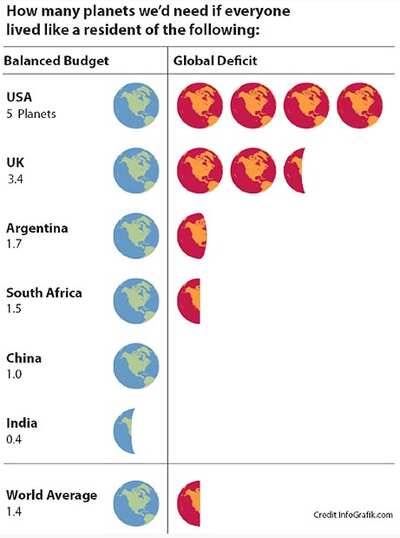
I did this simple online test to calculate my ecological footprint. The outcome was a 2.2, which means that if everybody has my lifestyle we would need 2.2 worlds. Compared to the average citizen of the United States (they score 5) my score isn’t that bad, but still we wouldn’t all fit on this planet. I already avoid the two most polluting activities: eating meat and driving a car. To get my footprint to the beautiful score of a 1.0, I should probably stop taking flights and buy less products. I could also protest against bad government policies, support organizations that fight global warming or I can boycott companies that contribute a lot to global warming such as Tata. But is it obligated that I, as just one individual, do something about global warming? Isn’t that the task of the government? Global warming is not my fault, right?
Lets suppose that the we all agree that the government has to do something about the global warming. The government has the moral obligation to make our country safe and liveable, also for the future. That doesn’t say anything about my individual moral obligation to do something about global warming. . Walter Sinnott-Armstrong (2010) tries to find the answer on what individual moral obligation concerning global warming is. He refers to the harm principle: We have a moral obligation not to perform an act that causes harm to others. However, the activities I perform (like using an airplane) do not directly harm another person. It’s not that because of my seat in a flight someone else has to inhale all of the exhaust. On the other hand, indirectly my seat can create a habit that will lead me to book a flight again or other people (family and friends) will follow me and also take a flight. This leads to the second principle of Sinnott-Armstrong: The indirect harm principle: We have a moral obligation not to perform an act that causes harm to others indirectly by causing someone to carry out acts that cause harm to others. Leading to the contribution principle: We have a moral obligation not to make problems worse, the gas principle: We have a moral obligation not to expel greenhouse gases into the atmosphere and the risk principle: We have a moral obligation not to increase the risk of harms to other people.
The stated principles imply that every act I perform violates a moral obligation. This theory about climate ethics confuses me. Maybe it’s best to just continue living my life, acting my activities, in a way that feels honest. If everyone does that, the world would be much better.
Bibliography
Facing the Future. (n.d.). Ecological footprint tour. Retrieved 11 25, 2014, from Facing the Future:
Global Warming Misunderstood?
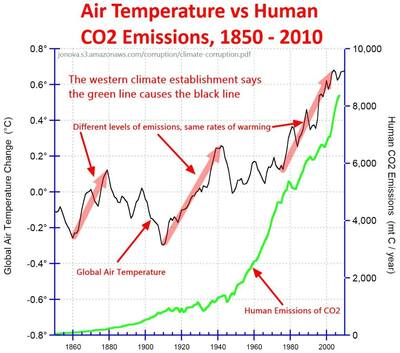
COLUMN 2
GLOBAL WARMING MISUNDERSTOOD?
There’s been a massive hue and a cry about global warming being an issue that will be detrimental for the lifestyle of the future generations and how rise in CO2 is correlated with this proposition. It is an undeniable truth that global warming is a reality; the world is heating up the temperatures are rising and the polar ice caps are melting. But have we got the reasons right? Can a rising level in CO2 be the major cause of concern for Global Warming?
Eminent personalities such as Al Gore have the world convinced that a rising level in CO2 is the primary cause of concern.
However, from the figure shown below the dull red arrows depict a rise in global temperature. Typically there are 3 and the CO2 line is shown in green. The green line is more of a steady increase from 1850 – 2010. On the other hand there is a rise and fall in temperatures thrice. This shows that green line does not relate to the black line.
So then, what is causing global warming? The rise in temperature from the 1960 – 2000 is almost 0.6oC. What has changed in this time? The population has increased exponentially causing a rise in need of transport, power and amenities. The latest investigation by Eui-Seok Chung states that water vapour is the major cause of global warming [1].
The effect water vapour has on Global Warming is almost double that of CO2 [2]. Water vapour rises and settles in the troposphere and then prevents long wave re-radiation of the land during the night from leaving the atmosphere and allows short wave radiation to enter in during the day. Similar to a greenhouse. This creates a positive feedback loop which causes the amount of global warming to increase in an exponential rate.
Not only water vapour but CFC’s were a major player as well as they react with Ozone to break it down and further increase Global Warming. However, with the successful sanctions on this chemical the levels of CFCs being produced have drastically reduced.
Though the battle to reduce Global Warming and combat polar ice caps from melting is going on there needs to be new direction to answer the relevant questions. Even if the direction is right there is a lack of support from the governments. Possibly when the axe is on our heads the governments will pump in money for research and Global Warming can finally reduce.
REFERENCES:
[1].http://www.rsmas.miami.edu/news-events/press-releases/2014/new-study-confirms-water-vapor-as-global-warming-amplifier
[2].http://www.newscientist.com/article/dn11652-climate-myths-co2-isnt-the-most-important-greenhouse-gas.html
[2]. http://www.nasa.gov/topics/earth/features/vapor_warming.html
The role of technology in sustainable development
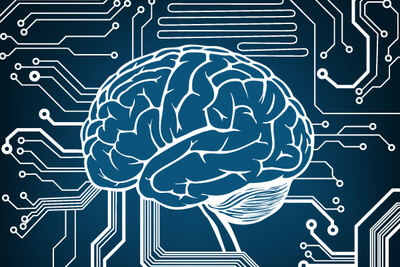
Many people rely on technology to solve environmental problems all over the world. This can be attributed to an almost universal reluctance to deal with the social and political changes that would be necessary to reduce production and consumption. This poses the most important question: Can Technological change reduce the impact of economic development sufficiently to ensure that other types of change will not be necessary to reach a fully sustainable world.
A fully sustainable world by the implementation of new technologies. Is this even possible at all? I believe it is not. At least, not by the hand of technology. The notion that technology could solely provide the change we need is based on the idea that a continual economic growth on our finite world is possible with new technologies. Although these might provide alternative solutions to short term problems, on the long run, technology will only help us to use what we have left in the most efficient manner available to our disposal.
This idea in itself is not sustainable in any way. It does not resolve the problem of exhausting limited resources. One way people think we could be remotely "sustainable" whilst exhausting these limited resources by only using technological change, would be if we can limit the use to such an extent that we find an alternative for the nearly depleted resource, and this resource has the time to regenerate sufficiently before its alternative is nearly depleted. Here, the next problem arises. Once a resource is depleted it is pretty hard to actually regerate the resource. Think about trees. Would forests quickly regenerate from one tree? No. Wood for example, would only become a sustainable resource if it would grow back as fast as we use it.
Planned obsolescence: devil or angel?

Have you ever own a product that is damaged just after the warranty is over? There are many reasons that can explain such phenomena and are mainly related to bad product care. However, sometimes we face a situation in which the product was designed to function properly just during a certain time period. Afterwards, some repairs, updates, new gadgets and other general improvements are needed in order for the product to be used normally. Moreover, sometimes it is cheaper just to through away the current product and buy a new one, fact encouraged by the throwaway culture promoted by nowadays consumerism... This does not look like a sustainable solution, does it?
Planned obsolescence is a topic of discussion regarding the social and environmental responsibility of engineers and designers around the word. Even though products may become obsolete for many reasons, such as the appearance of a new technological breakdown or changes in social interests, planned obsolescence costs consumers lots of money by making them buy new gadgets, pay for repair, or update services. Beyond the economic cost, the environmental costs are rising due to lack of proper waste management and the use of more resources to build new products to replace the old ones. Even though some degree of planned obsolescence is necessary for products to be affordable, (e.g. making all pieces of a phone to last for ten years would make too expensive and even not capable to keep up with technological innovations); the role of engineers and designers is critical to not to trespass limits of social and environmental responsibility during product planning
At this point, you can wonder how it can be possible: How engineers and designers can become guardians of sustainable product design. Well, obsolescence can also be planned to decrease the environmental impact of product’s waste once they are not going to be used anymore. Furthermore, a product can be designed to be easily recycled, reused or updated to follow technological developments; this would represent a step further in the switch towards a more environmentally friendly culture inside consumerism. As an example of such initiatives is dreamt by an organization called The Greener Grass, when planning to design not a smart phone but a product service system. Their main idea is for consumers not to buy but to lease the phone services for a year, after which you send back your old phone and receive a new one up to date with technological developments and with all your information included. The idea is to design phones in such a way that are easily dissembled and suitable for easy recycling.
Even though is still an idea, it serves as inspiration for us to think what can we do to merge two concepts seemingly opposite as planned obsolescence and sustainability in order to improve the way we use our resources and manage our waste. On the other hand, we can do some things as consumers to decrease the impact of planned obsolescence on the world: buy products with higher life span such as LED lights, try to fix things ourselves instead of throw them away immediately (learning is easy and fun – and youtube is full of lessons!), recycle as much as you can (there are firms specialized on handling electronic waste), and raise awareness about our social and environmental responsibility regarding planned obsolescence as well!
References
Dunn, C. (March 8, 2008). How Planned Obsolescence Can Be Good for the Planet. Retrieved from: http://www.treehugger.com/sustainable-product-design/how-planned-obsolescence-can-be-good-for-the-planet.html


 Bertien Broekhans
Bertien Broekhans
 Klara Bergman
Klara Bergman

 Borris
Borris
 Antonio D'Aquilio
Antonio D'Aquilio

 Derek van den Berg
Derek van den Berg

 Thalia
Thalia

 Tatiana Armijos Moya
Tatiana Armijos Moya

 Rosanne
Rosanne
 Iris
Iris

 Elia Galiouna
Elia Galiouna

 Jesper Goorden
Jesper Goorden
 Pinal Desai,
Pinal Desai,
 Irina
Irina
 Stefan Olsthoorn
Stefan Olsthoorn
 Dennis
Dennis
 Nora
Nora
 Stefan H
Stefan H

 Cheyenne Schuit
Cheyenne Schuit
 Thijs Schaap
Thijs Schaap
 Yannick
Yannick
 Lizet
Lizet

 Syed Aaquib Hazari
Syed Aaquib Hazari

 Pieter van Hall
Pieter van Hall

 María José Galeano Galván
María José Galeano Galván
